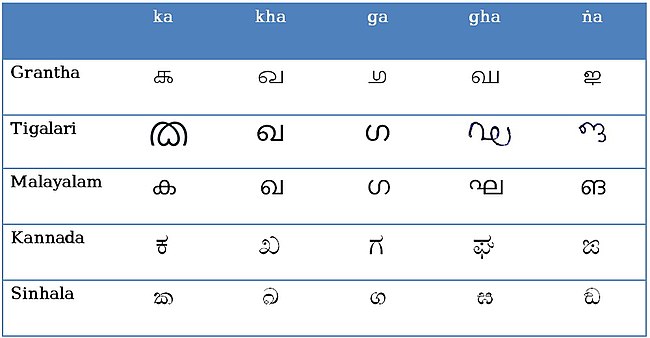Grantha script
| Grantha | |
|---|---|
 Grantha inscription at Bṛhadīśvara Temple, India | |
| Script type | |
Time period | 6th Century CE -present |
| Direction | Left-to-right |
| Languages | Malayalam, Sanskrit, Tamil |
| Related scripts | |
Parent systems | Brahmi
|
Child systems | Cham alphabet Tigalari alphabet Malayalam script Sinhala alphabet |
Sister systems | Vatteluttu alphabet, Kolezhuthu, Tamil script |
| ISO 15924 | |
| ISO 15924 | Gran (343), Grantha |
| Unicode | |
Unicode alias | Grantha |
| U+11300–U+1137F | |
The Grantha script (Tamil Kiranta eḻuttu, Malayalam Grantha lipi) was widely used between the sixth century and the 20th centuries by Tamil speakers in South India, particularly in Tamil Nadu and Kerala, to write Sanskrit and the classical language Manipravalam, and is still in restricted use in traditional Vedic schools (Sanskrit veda pāṭhaśālā).[1] It is a Brahmic script, having evolved from the Brahmi script in Tamil Nadu. The Malayalam script is a direct descendant of Grantha as are the Tigalari and Sinhala alphabets.
The rising popularity of Devanagari for Sanskrit and the political pressure created by the Tanittamil Iyakkam[2] for its complete replacement by the modern Tamil script led to its gradual disuse and abandonment in Tamil Nadu in the early 20th century, except for specialised Hindu religious literature. Grantha script still lives in Tamil Nadu, albeit in reduced state.
History
| Brahmic scripts |
|---|
| The Brahmi script and its descendants |
In Sanskrit, grantha is literally 'a knot'.[3] It is a word that was used for books, and the script used to write them. This stems from the practice of binding inscribed palm leaves using a length of thread held by knots. Although Sanskrit is now mostly written with Devanagari, Grantha was widely used to write Sanskrit in the Tamil-speaking parts of South Asia until the 19th century. Scholars believe that the Grantha script was used when the Vedas were first put into writing around the 5th century CE.[citation needed] In the early 20th century, it began to be replaced by Devanagari in religious and scholarly texts and the Tamil script (with the use of diacritics) in popular texts.
The Grantha script was also historically used for writing Manipravalam, a blend of Tamil and Sanskrit which was used in the exegesis of Manipravalam texts. This evolved into a fairly complex writing system which required that Tamil words be written in the Tamil script and Sanskrit words be written in the Grantha script. By the 15th century, this had evolved to the point that both scripts would be used within the same word – if the root was derived from Sanskrit it would be written in the Grantha script, but any Tamil suffixes which were added to it would be written using the Tamil script. This system of writing went out of use when Manipravalam declined in popularity, but it was customary to use the same convention in printed editions of texts originally written in Manipravalam until the middle of the 20th century.
In modern times, the Grantha script is used in certain religious contexts by orthodox Tamil-speaking Hindus. Most notably, they use the script to write a child's name for the first time during the nāmakaraṇa naming ceremony, and to write the Sanskrit portion of traditional wedding cards and announcements of a person's last rites. It is also used in many religious almanacs to print traditional formulaic summaries of the coming year.
Types of Grantha
Grantha script may be classified as follows:[4]
Pallava Grantha
An archaic and ornamental variety of Grantha is sometimes referred to as Pallava Grantha. They were used by the Pallava in some inscriptions. Mamallapuram Inscriptions, Tiruchirapalli Rock Cut Cave Inscriptions, Kailasantha Inscription come under this type.
The Pallavas also produced a distinctive script separate from the Grantha family.
Western Grantha
The Tigalari-Malayalam script is called Western Grantha. Currently two varieties are used: Brahmanic, or square, and Jain, or round. The Tigalari-Malayalam script was a variety of Grantha dating from the 8th or 9th century CE. It later split into two distinct scripts – Tigalari and Malayalam.[5]
This type of Grantha was used by Cholas approximately from 650 CE to 950 CE. Inscription of later Pallavas and Pandiyan Nedunchezhiyan are also examples for this variety of Grantha Script.
Medieval Grantha
Inscriptions of the Imperial Thanjavur Cholas are an example for Medieval Grantha. This variety was in vogue from 950 CE to 1250 CE.
Modern Grantha
Grantha in the present form descended from later Pandyas and the Vijayanagara rulers. The Modern form of Grantha is very similar to Malayalam alphabet and the Modern Tamil Script.
Grantha encoding
The font used in the following tables is e-Grantamil taken from INDOLIPI.
The glyphs below denote the late form of Grantha Script, which can be noticed by its similarity with the Modern Tamil Script.
Vowels
Consonants
As with other Abugida scripts Grantha consonant signs have the inherent vowel /a/. Its absence is marked with Virāma:
For other vowels diacritics are used:
Sometimes ligatures of consonants with vowel diacritics may be found, e.g.:
There are also a few special consonant forms with Virāma:
Consonant clusters
Grantha has two ways of representing consonant clusters. Sometimes, consonants in a cluster may form ligatures.
Ligatures are normally preferred whenever they exist. If no ligatures exist, "stacked" forms of consonants are written, just as in Kannada and Telugu, with the lowest member of the stack being the only "live" consonant and the other members all being vowel-less. Note that ligatures may be used as members of stacks also.
Special forms:
![]() ⟨ya⟩ when final in a cluster, and
⟨ya⟩ when final in a cluster, and ![]() ⟨ra⟩ when non-initial become
⟨ra⟩ when non-initial become ![]() and
and ![]() respectively. These are often called "ya-phalaa" and "ra-vattu" in other Indic scripts.
respectively. These are often called "ya-phalaa" and "ra-vattu" in other Indic scripts.
![]() ⟨ra⟩ as initial component of a cluster becomes
⟨ra⟩ as initial component of a cluster becomes ![]() (called Reph as in other Indic scripts) and is shifted to the end of the cluster but placed before any "ya-phalaa".
(called Reph as in other Indic scripts) and is shifted to the end of the cluster but placed before any "ya-phalaa".
Grantha numbers
Text samples
The Grantha text of each sample is followed by a transliteration into Latin (ISO 15919) and Devanāgarī scripts.
Example 1: Taken from Kālidāsa's Kumārasambhavam
- astyuttarasyāṁ diśi devatātmā himālayo nāma nagādhirājaḥ.
- pūrvāparau toyanidhī vagāhya sthitaḥ pr̥thivyā iva mānadaṇḍaḥ.
- अस्त्युत्तरस्यां दिशि देवतात्मा हिमालयो नाम नगाधिराजः।
- पूर्वापरौ तोयनिधी वगाह्य स्थितः पृथिव्या इव मानदण्डः॥
Example 2: St. John 3:16
- By comparing the old print from 1886 with the modern version given below one may see the difficulties the typesetter had with Grantha.
- yata īśvaro jagatītthaṁ prema cakāra yannijamekajātaṁ
- putraṁ dadau tasmin viśvāsī sarvamanuṣyo yathā
- na vinaśyānantaṁ jīvanaṁ lapsyate.
- यत ईश्वरो जगतीत्थं प्रेम चकार यन्निजमेकजातं
- पुत्रं ददौ तस्मिन् विश्वासी सर्वमनुष्यो यथा
- न विनश्यानन्तं जीवनं लप्स्यते।
Comparison with other scripts
Vowel signs
Note: As in Devanāgarī ⟨e⟩ and ⟨o⟩ in Grantha stand for [eː] and [oː]. Originally also Malayāḷam and Tamiḻ scripts did not distinguish long and short ⟨e⟩ and ⟨o⟩, though both languages have the phonemes /e/ /eː/ and /o/ /oː/. The addition of extra signs for /eː/ and /oː/ is attributed to the Italian missionary Constanzo Beschi (1680–1774).
{[Tamil script][ஃ= ஆகெனம்]} அஆஇஈஉஊஎஏஐஒஓஔஃ
Consonant signs
The letters ழ ற ன and the corresponding sounds occur only in Dravidian languages.
Another table that compares the consonants ka , kha, ga , gha, ṅa with other Southern Indic scripts such as Grantha, Tigalari, Malayalam, Kannada and Sinhala.
Unicode
Grantha script was added to the Unicode Standard in June 2014 with the release of version 7.0.
The Unicode block for Grantha is U+11300–U+1137F:
| Grantha[1][2] Official Unicode Consortium code chart (PDF) | ||||||||||||||||
| 0 | 1 | 2 | 3 | 4 | 5 | 6 | 7 | 8 | 9 | A | B | C | D | E | F | |
| U+1130x | 𑌀 | 𑌁 | 𑌂 | 𑌃 | 𑌅 | 𑌆 | 𑌇 | 𑌈 | 𑌉 | 𑌊 | 𑌋 | 𑌌 | 𑌏 | |||
| U+1131x | 𑌐 | 𑌓 | 𑌔 | 𑌕 | 𑌖 | 𑌗 | 𑌘 | 𑌙 | 𑌚 | 𑌛 | 𑌜 | 𑌝 | 𑌞 | 𑌟 | ||
| U+1132x | 𑌠 | 𑌡 | 𑌢 | 𑌣 | 𑌤 | 𑌥 | 𑌦 | 𑌧 | 𑌨 | 𑌪 | 𑌫 | 𑌬 | 𑌭 | 𑌮 | 𑌯 | |
| U+1133x | 𑌰 | 𑌲 | 𑌳 | 𑌵 | 𑌶 | 𑌷 | 𑌸 | 𑌹 | 𑌻 | 𑌼 | 𑌽 | 𑌾 | 𑌿 | |||
| U+1134x | 𑍀 | 𑍁 | 𑍂 | 𑍃 | 𑍄 | 𑍇 | 𑍈 | 𑍋 | 𑍌 | 𑍍 | ||||||
| U+1135x | 𑍐 | 𑍗 | 𑍝 | 𑍞 | 𑍟 | |||||||||||
| U+1136x | 𑍠 | 𑍡 | 𑍢 | 𑍣 | 𑍦 | 𑍧 | 𑍨 | 𑍩 | 𑍪 | 𑍫 | 𑍬 | |||||
| U+1137x | 𑍰 | 𑍱 | 𑍲 | 𑍳 | 𑍴 | |||||||||||
| Notes | ||||||||||||||||
References
Inline:
- ^ "Grantha". Ancient Scripts. Retrieved 2012-03-11.
- ^ The Tamil Purist Movement: A Re-evaluation, by K.Kailasapathy
- ^ MACDONNELL, ARTHUR. A HISTORY OF SANSKRIT LITERATURE. 1. LONDON: MOTILAL BANARASIDASS, 1900. 15. Print.
- ^ "EPIGRAPHY - Inscriptions in Grantha Script". Tnarch.gov.in. Retrieved 2012-03-11.
- ^ "Tulu-Malayalam script (writing system) - Britannica Online Encyclopedia". Britannica.com. Retrieved 2012-03-11.
Others:
- Reinhold Grünendahl: South Indian Scripts in Sanskrit Manuscripts and Prints, Wiesbaden (Germany) 2001, ISBN 3-447-04504-3
- K Venugopalan: A Primer in Grantha Characters.
- Tamil script Tamil script
External links
- Quick facts about Grantha at AncientScripts.com
- Article at Omniglot
- Tamil Nadu Archaeological Department – Grantha Webpage
- more about
- Digitised Grantha Books
- Software package with Grantha OpenType font and typewriter for Grantha and Manipravalam for Win XP, Vista, Win 7
- Online Tutorial for Grantha Script













